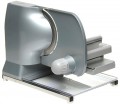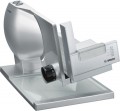Power
The total power consumption of the slicer. The value of this parameter is small — the performance of even the most powerful models usually does not exceed 200 W.
Almost all the power consumed is for operation of the engine, so the higher
it is, the more powerful the engine is installed in the slicer. Theoretically, the higher power allows you to better cope with solid and dense products, but in fact everything also depends on the characteristics of the knife — primarily its type (see below) and the quality of sharpening. Therefore, power data are more reference than practically significant, and this indicator has almost no effect on the quality of the slicer.
Blade type
The type of blade that comes standard with the slicer.
All knives used in this category of kitchen appliances are circular, rotating, and the blade in them goes in a circle. But the shape of this blade can be different — it is in this parameter that the types of knives differ from each other.
—
Straight. Knives with a traditional straight blade are basic and affordable, yet with proper sharpening and skill, they can handle various slicing tasks effectively. They excel with products of uniform consistency like cheese but may be less effective for slicing non-uniform density items such as bread compared to knives with wavy or notched blades.
—
Wavy. Knives with a wave-shaped blade are more difficult to manufacture and more expensive than straight ones. On the other hand, they do an excellent job not only with homogeneous products, but also with those that have different density — like ham with a crust.
—
Serrated. Serrated knives have sharpening in the form of pronounced sharp teeth, resembling those of a circular saw. They are beneficial for slicing products with varying density, similar to wavy blades. Serrated knives are particularly effective for cutting vegetables and fruits with tough peels and soft cores, like tomatoes or peaches. However, these knives tend to be more expensive due to their specialized design.
No
...te that some models may come with several removable blades of different types. This allows you to choose an option depending on the situation — for example, cut the cheese with a straight knife, and put the wavy one only when really necessary, so as not to wear it out much.Blade diameter
The diameter of the blade of the knife supplied with the slicer. Knives are shaped like discs — accordingly, the diameter of the blade is actually equal to the diameter of the disc.
The larger the blade, the larger ingredients the device can handle at a time and the “larger” the cut slices can be. At the same time, in fact it is rarely necessary to use a slicer for very thick products. Therefore, even in the most “large-caliber” modern models, the knife diameter usually does not exceed 300 mm.
Min. thickness of slice
The smallest thickness of slices that a slicer can separate from the cut product.
The modern slicers, usually, allow you to adjust the thickness of the slices — an important feature in light of the fact that for different situations and products, the optimal thickness will be different. It is worth paying attention to the minimum thickness if the ability to cut graceful thin slices is important for you — for example, for serving a holiday table, on which food should be not only tasty, but also beautiful.
Slicing tray
The presence
of a tray for chopped products in the design or delivery set of the slicer.
Such a pallet can be made both as a non-removable element and as a separate device that is not attached to the slicer body. However, this piece of equipment saves the user from having to look for a board, saucer, plate or other "seat" for chunks coming out from under the knife of the unit anyway. Of course, in a modern kitchen, finding such a “seat” is not a problem, but using a tray is often more convenient.
Compartment for cord
The presence
of a compartment for the power cord in the design of the slicer.
This feature greatly simplifies the storage and transportation of the device: the cord can be placed compactly inside the slicer body, and it will not hang out, cling to other objects and create other inconveniences. And in some models, the compartment may have devices for uniform winding, which makes it easier to lay the wire and avoid damage due to bending.

